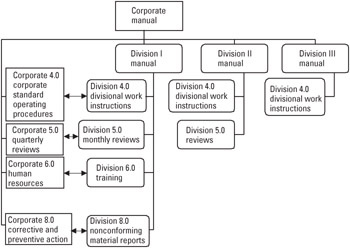5.14 Multidivisional Manuals
|
5.14 Multidivisional Manuals
Our discussion can be readily expanded to include very large organizations with multidivisional requirements. Regardless of which basic configuration is chosen, the divisional documents would follow directly (e.g., the corporate manual would deal with policy at the highest level and the divisional manuals would respond to each corporate policy according to the specific operational characteristics of the division).
The corporate manual references the divisional manuals as appropriate. Some examples of the content of a divisional manual versus the corporate manual are summarized in Table 5.18.
| Subject | Corporate Manual | Divisional Manual |
|---|---|---|
| 5.6: Management Review | Discusses the quarterly management review held at the corporate offices with divisional managers present Describes the various corporate preparatory meetings that take place prior to the quarterly review | Discusses the monthly divisional management review that feeds the corporate quarterly review Also discusses the divisional preparatory meetings held locally prior to the monthly review |
| 4.1: General QMS Requirements | Describes the entire QMS and references corporate standard operating procedures (CSOPs) or corporate process documents (CPDs) Discusses the various ways that the divisions interface with both the corporate office and other divisions | Describes the response to the CSOPs via divisional work instructions (DWIs) Describes specific interface functions with corporate and other divisions Divisional SOPs or process documents are optional and are generally redundant |
| 7.2: Customer-Related Processes | Describes the highest level marketing and sales policies and methods References the corporate marketing and sales process manual | Describes the method used at the divisional level to meet the corporate marketing and sales policies. Describes the response to the corporate marketing and sales process by means of DWIs. |
A schematic of such a multidivisional manual structure, which follows the direct sequence pattern of the Standard, is shown in Figure 5.11.

Figure 5.11: Possible configuration for a corporate/ divisional integrated manual.
5.14.1 ISO Management Review—Example of Labels
The block labeled "Corporate 5.0 quarterly reviews" represents the corporate response to the SHALLS in Section 5.0: Management Responsibility of the Standard. One of the key elements of this section has to do with the quarterly corporate management reviews and monthly divisional management reviews that are usually coordinated by the ISO 9000 management representative (see Clause 5.5.2: Management Representative). The assignment of the representative might be handled in the following manner at corporate and subsequently at division.
Partial corporate assignment memo: "The president has designated the corporate director of quality assurance as the ISO 9000 management representative. A memo to this effect, which defines the additional duties and authority of this position, has been released by the president of the corporation and distributed to all employees of the corporation…"
The block labeled "Division 5.0 monthly reviews" represents the divisional response to the corporate assignment of an ISO 9000 management representative.
Partial division assignment memo: "The general manager has designated the division's manager of quality assurance as the site ISO 9000 management representative who will coordinate such activities with the corporate director of quality assurance. Notice to all divisional employees was by means of the weekly quality improvement reviews held with the division's general manager and was made a part of the review minutes. The minutes included the additional duties and authority of this position..."
5.14.2 Summary and Conclusion
In this manner, each division responds in kind to the various corporate quality policy statements in order to form a cohesive and coherent body of corporate knowledge. Each division also shares the top-most level II documents (e.g., document control procedures, corrective and preventive action procedures, internal audit programs, and training manuals). Tier III and tier IV documents are designed expressly for use by a given division.
We have observed that the manual controversy occurs because although the supplier has chosen to write a stand-alone manual, the writers have been inconsistent with regard to the location of the quality policy statements that often appear in the lower tier documents.
We have found this tendency to confuse policy with process and process with procedure, independent of either organizational size or type of industry. In many cases, the SOPs are primarily statements of policy and the work instructions contain process descriptions.
We believe that a great deal of redundancy and misunderstanding could be avoided if authors always chose to use the following:
-
Stand-alone manual configuration;
-
Hub document approach;
-
Stand-alone manual as the location of the quality policy statements.
|
EAN: 2147483647
Pages: 155
- The Four Keys to Lean Six Sigma
- Key #1: Delight Your Customers with Speed and Quality
- Making Improvements That Last: An Illustrated Guide to DMAIC and the Lean Six Sigma Toolkit
- The Experience of Making Improvements: What Its Like to Work on Lean Six Sigma Projects
- Six Things Managers Must Do: How to Support Lean Six Sigma